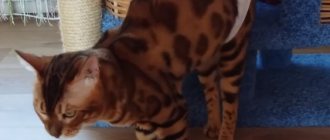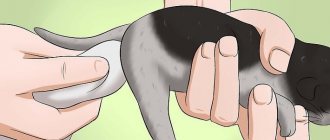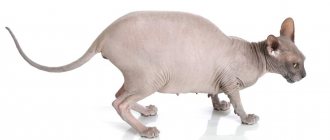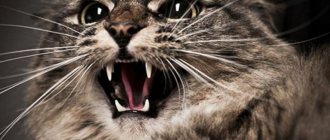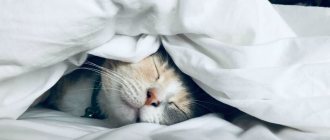Why do kittens have an enlarged belly, and what can we do to bring the animals’ digestive tract back to normal?
You've taken a mischievous furry creature into your home and can't get enough of its playfulness. In an effort to make the kitten grow up as quickly as possible, you probably think that he needs to eat more and start feeding him the same thing that you eat yourself. A large belly can paralyze the kitten’s digestive tract.
True, a big belly does not only arise from poor nutrition. The consequences of such a condition can be dangerous. Let's see why kittens have an enlarged belly and what we can do to bring the animals' digestive tract back to normal.
Causes of abdominal enlargement in kittens
The most common reason for an enlarged belly in a kitten is feeding rough food. Remember that food intended for adult animals is not suitable for small ones. As a result, the kitten will suffer from colic and his health will worsen.
Constipation is another reason for an enlarged belly in an animal. You may notice that it has become hard. This happens due to the accumulation of feces. You can check whether a kitten's belly is enlarged by lightly palpating it. Seals in some places indicate that a huge amount of feces has accumulated in the animal’s intestines.
When you overeat, a seal also forms in the intestines. Systematic overfeeding of the animal leads to the fact that it moves with difficulty and sleeps most of the time. And reduced physical activity, in turn, leads to constipation.
And one more danger that cannot be ignored is worms. If you do not know whether your pet has these parasites, it should be taken to the veterinarian. Massive infestation with worms leads to very unfavorable consequences and can even cause the death of the animal.
Causes of vomiting
If a cat starts vomiting, then first of all the owner needs to calm down and not show fear prematurely. The thing is that very often vomiting acts as a protective reflex of the body. For example, if a cat vomits in the morning, then most likely it is caused by simple hunger. If this is the case, then as soon as he eats, his nausea will immediately go away.
Another cause of vomiting can be overeating. But this only happens when the owner does not monitor the diet.
© shutterstock
But, of course, nausea can also signal serious problems. The presence of parasites can cause vomiting. Two symptoms, the cat is vomiting and diarrhea, this is a signal that it has been poisoned by bad food.
Signs of an enlarged abdomen in cats
A kitten may overeat and after eating a portion of tasty food, his stomach feels like his stomach is about to burst. Or he ate very little, and his tummy is swollen.
A kitten's bloated belly can be accompanied by the following symptoms:
- Vomit. When overeating, as well as in order to free the digestive tract from foreign objects, it is usually one-time use.
- Diarrhea. Often in young animals it appears as a result of incorrectly chosen food. Diarrhea is a dangerous symptom, as it may indicate a parasitic infection.
- The appearance of dead helminths in the feces indicates a massive parasitic infection. This condition is also dangerous, since parasites poison the body with waste products.
- Perversion in appetite indicates the desire of kittens to eat inedible or difficult to digest foods. This phenomenon often indicates that the animal lacks vitamins and microelements.
- Inflammatory processes in the oral cavity indicate irritation of the digestive tract. As a result of irritating chemicals entering the stomach, the tummy becomes enlarged and causes severe pain.
- Flatulence is observed very often in kittens. The kitten's intestines are swollen. The kitten is often restless, he runs and rushes about.
Color and types of vomit
In addition to white, foam can be yellow, brown, green or reddish:
- If white mucus is observed in the vomit, this indicates the presence of worms.
- A cat vomiting water or saliva with foam is a reason to think about it. This may indicate dangerous diseases, such as cat distemper.
- The reddish tint of the foam indicates possible internal damage and bleeding.
- The gray color is associated with unsuitable food.
- If a cat vomits yellow foam or bile, then gastritis, feline distemper, etc. are possible.
- Vomiting of water and white foam in a cat – possible encephalitis, suspected tumor.
- When a cat vomits green foam, there may be stomach problems.
- Feces in vomit - serious damage to the intestines is possible.
When to see a doctor
Contact your veterinarian immediately if your animal has a large intestine combined with excessive drooling, retching, or vomiting. In addition, a visit to a veterinarian is mandatory in order to exclude the following life-threatening pathological conditions:
- liver diseases;
- massive infection with worms;
- diseases (including malignant) of the pancreas;
- abnormalities in the functioning of the immune system;
- obesity.
What to do if your cat vomits white foam?
The first thing to do is to limit the cat’s food, or rather, to remove it for 1 day. If this is due to poisoning/overeating, etc., then the body will rest and start up again. Of course, if you are sure that the white foam is not related to the animal’s hunger strike. A weak solution of potassium permanganate or water with a small concentration of Smecta can help the animal.
The most important thing is to monitor your pet’s condition: if you see that he is getting worse and worse, do not hesitate, go to the doctor. If a cat vomits frequently, for more than a day, then severe dehydration occurs.
To accurately determine the cause of vomiting, you will need the following information: how often it happens, assumptions about why the kitten may be vomiting, observations of the color and content of the vomit. The doctor will examine your pet and order a general urine and blood test, ultrasound and x-ray.
When a bloated stomach is not related to nutrition
Be careful, as the stomach may be bloated for reasons independent of the state of the digestive system. So, an increase in abdominal volume can be observed with the following cat diseases:
- megacolon - compaction of fecal matter and increase in intestinal volume;
- adrenal function disorder;
- ascites - accumulation of fluid in the abdominal cavity as a result of liver and heart diseases;
- obesity;
- presence of intrauterine infection;
- bladder rupture;
- spleen tumor.
So, if you notice a bloated belly in your kitten, you need to contact your veterinarian.
Vomit
Vomit also varies in color and consistency. And sometimes it can help identify the causes of illness.
- When a cat doesn't eat and vomits white foam, it could be a symptom of liver disease. The way you feel sick also plays an important role. For example, if you vomited once, then most likely nothing bad happened. But if the cat begins to vomit heavily, several times an hour, then it is not safe to postpone contacting the veterinarian.
- Bloody masses are a symptom of internal organ damage
- Yellow. Most likely, digestion is impaired, bile enters the stomach
- Green color. May indicate problems with the gallbladder. Or maybe it’s just because I ate too much fresh greens
A common reason why a cat vomits is because fur gets into the stomach.
Big belly treatment
Cat owners need to know what to do if their cat has a swollen belly. First of all, this is a visit to the doctor and full compliance with his recommendations. There is no need to try to perform any procedures on him without the recommendation of a veterinarian.
Treatment of ascites is carried out only if the underlying disease is diagnosed. Diuretics are prescribed, fluid intake is limited, and the diet is enriched with protein foods. If the amount of liquid has not decreased, it is pumped out with a special syringe.
When infected with worms, the kitten is dewormed. This is done with the help of anthelmintic drugs.
If a kitten’s belly is swollen as a result of poor nutrition, then corrective measures are taken:
- use of special feeds;
- diet restriction;
- fight against constipation;
- introducing a sufficient amount of microelements and vitamins into the diet;
- sufficient physical activity.
Prevention of the disease comes down to proper nutrition, physical activity and timely detection of helminthiases. It is important to combat obesity and impaired water-salt metabolism to prevent ascites.
Opinion and advice on treating vomiting in a cat from a veterinarian
Most experts believe that nausea in pets is usually a consequence of improper care and nutrition.
If the animal's condition worsens, it is recommended:
- Analyze your diet. Poor or low-quality food in most cases leads to diseases of the gastrointestinal tract. You need to choose the right diet and organize fractional drinking.
- Measure body temperature. In case of infection or inflammation it will rise, in case of poisoning it will decrease.
- Analyze the composition and smell of vomit. This may indicate a possible cause for the worsening condition and may also help your veterinarian make a diagnosis.
- If vomiting occurs in small kittens, you should immediately consult a doctor. Their body is not yet strong, and any deterioration in health can lead to death.
- Do not self-medicate. It may be wrong and have dire consequences.
Self-diagnosis
The appearance of vomiting and the behavior of the kitten cannot make a final diagnosis, but the owner can assess the general condition of the animal and make a preliminary decision on its treatment. If something changes later, the decision may need to be revised.
© shutterstock
Encouraging signs
You don’t have to worry too much and limit yourself to home treatment if the following easily noticeable signs are observed:.
- The kitten vomited undigested or poorly digested food once - this happens from overeating.
- The kitten behaves actively, does not refuse water and food, and no additional symptoms are observed.
- It was possible to see fur in the vomit.
- The kitten recently arrived in the house and vomiting is not accompanied by a refusal of water, convulsions, or an increase in temperature - most likely, the unusual diet is to blame. It’s worth analyzing it and asking the cat’s owner what kind of food the kitten previously needed.
It is almost certain that if such symptoms are present, the vomiting will stop quickly and there will be no consequences. If the symptoms persist, the help of a veterinarian will still be required.
Threatening symptoms
But there are signs when it is better to immediately seek advice from a specialist..
- A kitten vomits blood - a sign of mechanical damage to the esophagus or stomach or severe internal pathologies.
- Vomiting occurs repeatedly, and bile is present in the mass (it is yellow) - serious disturbances in the functioning of the liver and bile ducts are possible.
- There is white foam in the vomit - this may indicate infection.
- Worms were found in the mass - they should be removed immediately.
- Vomiting is accompanied by diarrhea - a sign of poisoning.
- A kitten refuses to eat and does not drink - a threat to life, whatever the reason.
- Vomiting is accompanied by convulsions, apathy, and fever.
Yes, kittens can vomit (just like children) for minor reasons, “in the mood.” But, if the owner notices at least some threatening signs, he should immediately begin to treat the animal, because otherwise it may be too late.
